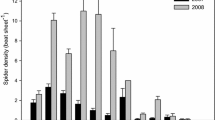Abstract
Field data from 48 plots monitored during diverse weather conditions in two separate years were subjected to multiple regression analysis to determine which factors were related to spider-mite aerial dispersal. With the number of aerially dispersing mites as the dependent variable, partial regression coefficients (b) for mite population density and percent corn-leaf area infested with mites were positive, while those for percentNeozygites-infected mites and hours per week ≥90% r.h. were negative. When an aerial dispersal index (number of aerially dispersing mites/mites per plant) was used as the dependent variable, the partial regression coefficient for percent leaf area infested was positive, while coefficients for hours per week ≥90% r.h. and percentNeozygites-infected mites were negative. Mite aerial dispersal was greatest in predator-suppressed field plots under dry weather conditions. Mite aerial dispersal was substantially reduced in plots where moist weather conditions induced epizootics ofNeozygites floridana before corn plants became entirely infested with mites.
Similar content being viewed by others
References
Boykin, L.S. and Campbell, W.V., 1984. Wind dispersal of the twospotted spider mite (Acari: Tetranychidae) in North Carolina peanut fields. Environ. Entomol., 13: 212–227.
Boyle, W.W., 1957. On the mode of dissemination of the two-spotted spider mite,Tetranychus telarius (L.) (Acarina: Tetranychidae). Proc. Hawaii. Entomol. Soc., 16: 261–268.
Brandenburg, R.L. and Kennedy, G.G., 1982. Intercrop relationships and spider mite dispersal in a corn-peanut agroecosystem. Entomol. Exp. Appl., 32: 269–276.
Carey, J.R., 1982. The within-plant distribution of tetranychid mites on cotton. Environ. Entomol., 11: 796–800.
Ebeling, W., 1934. Observations on a method of dissemination employed by mites. Pan-Pac. Entomol., 10: 89.
Ferro, D.N. and Southwick, E.E., 1984. Microclimates of small arthropods: estimating humidity within the leaf boundary layer. Environ. Entomol., 13: 926–929.
Fleschner, C.A., Badgely, M.E., Richer, D.W. and Hall, J.C., 1956. Air drift of spider mites. J. Econ. Entomol., 49: 624–627.
Gerson, U., 1979. Silk production inTetranychus (Acari: Tetranychidae). In: J.G. Rodriguez (Editor), Recent Advances in Acarology., Vol. 1. Academic Press, New York, pp. 177–188.
Gilstrap, F.E., Summy, K.R., Chandler, L.D., Archer, T.L. and Ward, C.R., 1980. Within-plant distribution of Banks grass mite on corn in west Texas. Environ. Entomol., 9: 546–548.
Hussey, N.W. and Parr, W.J., 1963. Dispersal of the glasshouse red spider mite. Entomol. Exp. Appl., 6: 207–214.
Iftner, D.C. and Hall, F.R., 1983. Effects of fenvalerate and permethrin onTetranychus urticae Koch (Acari: Tetranychidae) dispersal behavior. Environ. Entomol., 12: 1782–1786.
Kennedy, G.G. and Smitley, D.R., 1986. Dispersal. In: W. Helle and M.W. Sabelis (Editors), Spider Mites, Their Biology, Natural Enemies and Control, Vol. 1A. Elsevier, Amsterdam, pp. 233–242.
Margolies, D.C. and Kennedy, G.G., 1985. Movement of the twospotted spider mite,Tetranychus urticae Koch (Acari: Tetranychidae), between hosts in a corn-peanut agroecosystem. Entomol. Exp. Appl., 37: 55–61.
Marle, G., 1951. Observations on the dispersal of the fruit tree red spider mite,Metatetranychus ulmi (Koch). Annual Report, East Malling Research Station, 1950, pp. 155–159.
McEnroe, W.D., 1969. Spreading and inbreeding in the spider mites. J. Hered., 60: 343–345.
McEnroe, W.D. and Dronka, K., 1971. Photobehavioral classes of the spider mite,Tetranychus urticae. Entolmol. Exp. Appl., 14: 420–424.
Mitchell, R., 1973. Growth and population dynamics of a spider mite (Tetranychus urticae K., Acarina: Tetranychidae). Ecology, 54: 1349–1355.
Ramsey, J.A., Butler, G.G. and Sang, J.H., 1937. The humidity gradient at the surface of a transpiring leaf. J. Appl. Biol., 17: 255–265.
Sanderson, J.B., Daynard, T.B. and Tollenaar, M., 1981. A mathematical model of the shape of corn leaves. Can. J. Plant Sci., 61: 1009–1011.
Silberman, L.L., 1984. Aerial dispersal of the twospotted spider mite,Tetranychus urticae Koch, from its host plants. M.S. thesis, NC State Univ., Raleigh, NC, 68 pp.
Smitley, D.R. and Kennedy, G.G., 1985. Photo-oriented aerial dispersal behavior ofTetranychus urticae (Acari: Tetranychidae) enhances escape from the leaf surface. Ann. Entomol. Soc. Am., 78: 609–614.
Stabler, H.P., 1913. Red spider spread by winds. Mon. Bull. Calif. State Comm. Hortic., 2: 777–780.
Suski, Z.W. and Naegele, J.A., 1966. Light response in the twospotted spider mite. II. Behavior of the ‘sedentary’ and ‘dispersal’ phases. In: J.A. Naegele (Editor), Advances in Acarology, Vol. 1. Comstock Publishing, Ithaca, NY, pp. 445–453.
Author information
Authors and Affiliations
Rights and permissions
About this article
Cite this article
Smitley, D.R., Kennedy, G.G. Aerial dispersal of the two-spotted spider mite (Tetranychus urticae) from field corn. Exp Appl Acarol 5, 33–46 (1988). https://doi.org/10.1007/BF02053815
Accepted:
Issue Date:
DOI: https://doi.org/10.1007/BF02053815




